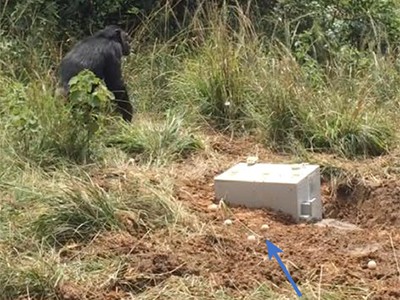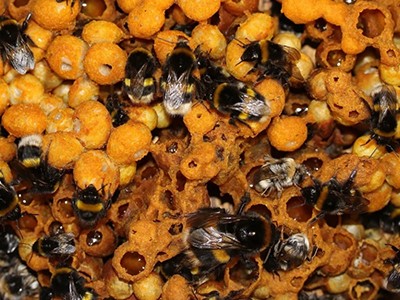You and I are both, biologically speaking, African apes, but I am writing this on a laptop in Cornwall, and you might be reading it in Colombo, Caracas or Canberra. This reflects one of the most remarkable attributes of the human species — the progressive improvement of skills and technologies as innovations spread and are built on, a phenomenon called cumulative culture. Studies by Bridges et al.1 in Nature and van Leeuwen et al.2 in Nature Human Behaviour shed light on the capacity of other animals to demonstrate the type of skill that might be needed to achieve cumulative culture.

Read the paper: Bumblebees socially learn behaviour too complex to innovate alone
Improvements in the products of human culture, such as tools and technologies, have enabled humanity to spread across the globe, transform ecosystems and probe the farthest reaches of space. Other animals show modest forms of cumulative culture — for example, homing pigeons (Columba livia) refine the efficiency of their flight routes by learning from each other3 — but the scope and scale of human cumulative culture clearly outstrips anything observed in the natural world. Why might this be the case? One influential argument4 states that only humans can learn from others things that are beyond what they could learn independently, exceeding what is called a zone of latent solutions (those that an individual might be able to invent alone). The research by Bridges et al. and van Leeuwen et al., examining two notably different species, cast serious doubt on this supposed human exceptionalism.
At a sanctuary in Zambia, van Leeuwen and colleagues presented two groups of chimpanzees (Pan troglodytes) with a multi-step task involving an apparatus similar to a vending machine. To obtain a reward of peanuts, a chimpanzee had to retrieve a wooden ball, pull and hold open a drawer on the machine, slot in the ball and then close the drawer to release the peanuts (Fig. 1a). The chimpanzees explored the task, but over a period of 3 months, no individual among the 66 tested solved it. However, after the experimenters trained 2 chimpanzees to solve the task and the animals acted as demonstrators, the solution spread across the apes’ social network, resulting in 14 individuals learning how to solve the task.

Figure 1 | Animals other than humans can learn skills that one individual could probably not achieve in their lifetime. Scientists examined the ability of chimpanzees and bees to solve a complex task through innovation over an extended period of time. a, van Leeuwen et al.2 reveal that chimpanzees can learn to complete a task that they could not solve by innovation alone over the course of three months. Chimpanzees gained the ability to complete the task by watching an individual demonstrator that had been trained to solve the task. b, Bridges et al.1 show that this capacity is also present in invertebrates, because bumblebees can socially learn to solve a task that individuals could not solve by innovation over the course of up to 24 days — longer than most bumblebees spend foraging during their lifetime. The bee has to move two tabs to solve the task. The red tab is attached to an opening in the upper layer of the plastic that provides access to the sugar treat when the opening is moved above the reward.
Hence, chimpanzees seem to join humans in the club of animals that, through observation, can learn skills that are difficult, if not impossible, to learn alone. This might, in principle, enable cumulative culture because many could learn from advances made by rare innovators. But perhaps the result of this experiment is not so surprising given that chimpanzees have large brains and rich cultural lives, including the ability to develop traditions of foraging techniques and tools that differ between communities5.

Read the paper: Chimpanzees use social information to acquire a skill they fail to innovate
Bridges and colleagues’ study is all the more remarkable because it focuses not on humanity’s primate cousins, but on the humble bumblebee (Bombus terrestris) — an animal with a brain that is barely 0.0005% of the size of a chimpanzee’s. These authors used a two-step puzzle box in which a bee first had to move a blue tab out of the way to reach a red tab, which could then be pushed to access a sugar treat (Fig. 1b). Over periods of 12 or 24 days, no bee across 3 colonies tested worked this out. Then, through a painstaking process, the authors used rewards to train nine bees to learn the solution and thus become demonstrators for the other bees. Strikingly, 5 of the 15 bees that were then exposed to demonstrators learnt the task themselves. These are small sample sizes, but the point is clear — the task was exceptionally hard to learn alone, yet some bees could solve it through social learning.
It is possible that some individuals in the studies might have innovated the task solution had they been given more time. After all, 3 months is not that long a time frame for a chimpanzee that might live for 40 years or more. By contrast, the average bumblebee spends only 8 days of its life foraging, so the 12–24 days in Bridges and colleagues’ study might be as close as scientists will ever get to testing what animals are capable of in their lifetimes.
But what if more individuals had participated in the experiments? This demonstrates a general difficulty in testing the hypothesis based on the zone of latent solutions. How can a researcher ever be satisfied that a task is too difficult to solve alone? And can we really define the zone of latent solutions for a particular species, given that cognitive abilities, skills and knowledge vary widely between individuals in that species, depending on their genes and developmental experiences5,6?

The role and rule of relatedness in altruism
Of course, the social transmission of behaviours acquired through human training does not show that bumblebees or chimpanzees socially learn such complex skills in the wild. Moreover, both studies involved a single episode of social learning, so they cannot explicitly test the potential for the progressive improvements in skills that characterize cumulative culture. The chimpanzee research has intriguing parallels with natural behaviours such as nut-cracking — a multi-step skill that some suggest is too complex for chimpanzees to learn alone and so must be an outcome of cumulative culture7. However, rather than telling us about cumulative culture in bumblebees and chimpanzees, a strength of these studies might be what they reveal about humans.
People habitually overestimate their abilities relative to those of other animals and are drawn to ‘silver bullet’ explanations of human cognition and culture8. This research suggests that the ability to learn from others what cannot be learnt alone should now join tool use, episodic memory (the ability to recall specific past events) and intentional communication in the scrapheap of discarded silver bullets8. There is also no need to appeal to specialized forms of social learning, such as imitating others’ body movements — the bumblebees learnt simply because by following closely behind knowledgeable demonstrators, they gained experience of the task. Many researchers studying humans are reaching similar conclusions. For instance, experiments show that the imitation of body movements is not necessary to achieve cumulative improvements in tool designs9,10.
If chimpanzees and bumblebees can learn from others what cannot be learnt alone, then this ability is unlikely to be an explanation for humanity’s distinctive cumulative culture. Rather than an explanation, it might instead be an outcome — cumulative culture produces products, such as the laptop I am using now, that are much too complex for any one of us to invent alone. Perhaps it is time to abandon silver bullets and focus instead on unravelling how the co-evolutionary web of feedback between innovation, social learning and social structure gives rise to the complex culture on which humans all depend5,8,10.
Competing Interests
Table of Contents
The author declares no competing interests.
